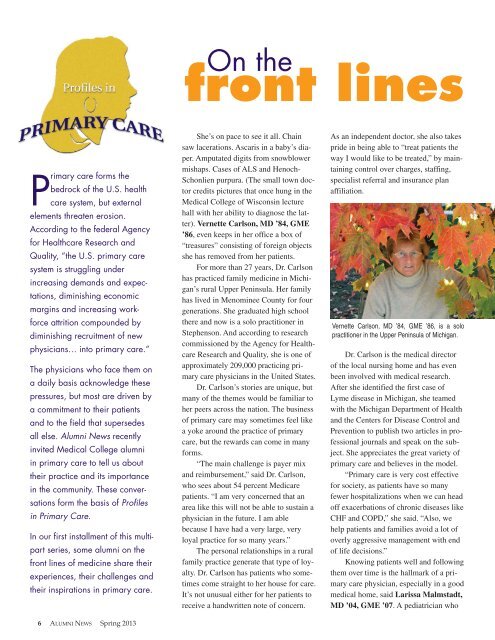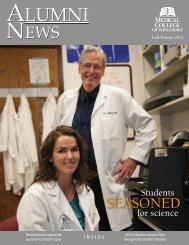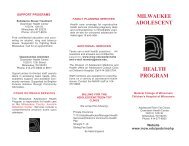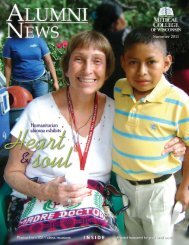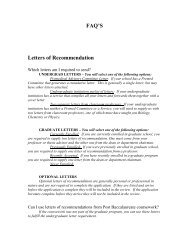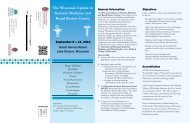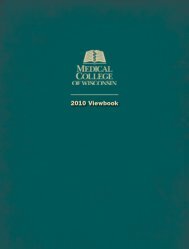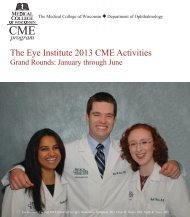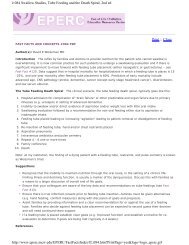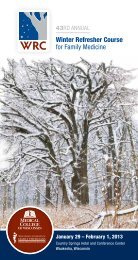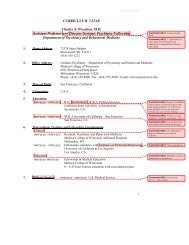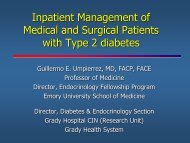Spring 2013 issue (pdf) - Medical College of Wisconsin
Spring 2013 issue (pdf) - Medical College of Wisconsin
Spring 2013 issue (pdf) - Medical College of Wisconsin
Create successful ePaper yourself
Turn your PDF publications into a flip-book with our unique Google optimized e-Paper software.
On the<br />
front lines<br />
Primary care forms the<br />
bedrock <strong>of</strong> the U.S. health<br />
care system, but external<br />
elements threaten erosion.<br />
According to the federal Agency<br />
for Healthcare Research and<br />
Quality, “the U.S. primary care<br />
system is struggling under<br />
increasing demands and expectations,<br />
diminishing economic<br />
margins and increasing workforce<br />
attrition compounded by<br />
diminishing recruitment <strong>of</strong> new<br />
physicians… into primary care.”<br />
The physicians who face them on<br />
a daily basis acknowledge these<br />
pressures, but most are driven by<br />
a commitment to their patients<br />
and to the field that supersedes<br />
all else. Alumni News recently<br />
invited <strong>Medical</strong> <strong>College</strong> alumni<br />
in primary care to tell us about<br />
their practice and its importance<br />
in the community. These conversations<br />
form the basis <strong>of</strong> Pr<strong>of</strong>iles<br />
in Primary Care.<br />
In our first installment <strong>of</strong> this multipart<br />
series, some alumni on the<br />
front lines <strong>of</strong> medicine share their<br />
experiences, their challenges and<br />
their inspirations in primary care.<br />
6 ALUMNI NEWS <strong>Spring</strong> <strong>2013</strong><br />
She’s on pace to see it all. Chain<br />
saw lacerations. Ascaris in a baby’s diaper.<br />
Amputated digits from snowblower<br />
mishaps. Cases <strong>of</strong> ALS and Henoch-<br />
Schonlien purpura. (The small town doctor<br />
credits pictures that once hung in the<br />
<strong>Medical</strong> <strong>College</strong> <strong>of</strong> <strong>Wisconsin</strong> lecture<br />
hall with her ability to diagnose the latter).<br />
Vernette Carlson, MD ’84, GME<br />
’86, even keeps in her <strong>of</strong>fice a box <strong>of</strong><br />
“treasures” consisting <strong>of</strong> foreign objects<br />
she has removed from her patients.<br />
For more than 27 years, Dr. Carlson<br />
has practiced family medicine in Michigan’s<br />
rural Upper Peninsula. Her family<br />
has lived in Menominee County for four<br />
generations. She graduated high school<br />
there and now is a solo practitioner in<br />
Stephenson. And according to research<br />
commissioned by the Agency for Healthcare<br />
Research and Quality, she is one <strong>of</strong><br />
approximately 209,000 practicing primary<br />
care physicians in the United States.<br />
Dr. Carlson’s stories are unique, but<br />
many <strong>of</strong> the themes would be familiar to<br />
her peers across the nation. The business<br />
<strong>of</strong> primary care may sometimes feel like<br />
a yoke around the practice <strong>of</strong> primary<br />
care, but the rewards can come in many<br />
forms.<br />
“The main challenge is payer mix<br />
and reimbursement,” said Dr. Carlson,<br />
who sees about 54 percent Medicare<br />
patients. “I am very concerned that an<br />
area like this will not be able to sustain a<br />
physician in the future. I am able<br />
because I have had a very large, very<br />
loyal practice for so many years.”<br />
The personal relationships in a rural<br />
family practice generate that type <strong>of</strong> loyalty.<br />
Dr. Carlson has patients who sometimes<br />
come straight to her house for care.<br />
It’s not unusual either for her patients to<br />
receive a handwritten note <strong>of</strong> concern.<br />
As an independent doctor, she also takes<br />
pride in being able to “treat patients the<br />
way I would like to be treated,” by maintaining<br />
control over charges, staffing,<br />
specialist referral and insurance plan<br />
affiliation.<br />
Vernette Carlson, MD ’84, GME ’86, is a solo<br />
practitioner in the Upper Peninsula <strong>of</strong> Michigan.<br />
Dr. Carlson is the medical director<br />
<strong>of</strong> the local nursing home and has even<br />
been involved with medical research.<br />
After she identified the first case <strong>of</strong><br />
Lyme disease in Michigan, she teamed<br />
with the Michigan Department <strong>of</strong> Health<br />
and the Centers for Disease Control and<br />
Prevention to publish two articles in pr<strong>of</strong>essional<br />
journals and speak on the subject.<br />
She appreciates the great variety <strong>of</strong><br />
primary care and believes in the model.<br />
“Primary care is very cost effective<br />
for society, as patients have so many<br />
fewer hospitalizations when we can head<br />
<strong>of</strong>f exacerbations <strong>of</strong> chronic diseases like<br />
CHF and COPD,” she said. “Also, we<br />
help patients and families avoid a lot <strong>of</strong><br />
overly aggressive management with end<br />
<strong>of</strong> life decisions.”<br />
Knowing patients well and following<br />
them over time is the hallmark <strong>of</strong> a primary<br />
care physician, especially in a good<br />
medical home, said Larissa Malmstadt,<br />
MD ’04, GME ’07. A pediatrician who


